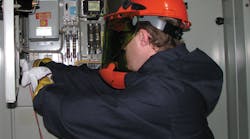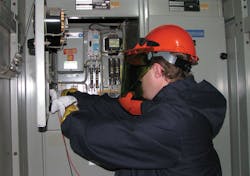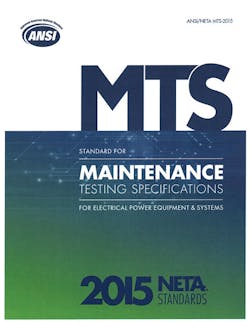What does risk really mean when working with electrical systems, and how do electrical workers decide what elements go into a risk assessment? As qualified electrical workers, we seem to identify hazards pretty well, but the concept of risk is pretty vague. Actually, everyone assesses risk all the time — whether you’re playing sports or even just crossing the street, you have to weigh the chances of something unsafe actually unfolding. So what are the factors that go into risk analysis?
In the beginning
Companies will have some method of assessing the hazards and risks associated with a given task. Whether it is called a job safety analysis, job hazard analysis, or some other name, documenting the method used to determine the risks and what personal protective equipment (PPE) is needed must be completed. The 2015 edition of NFPA 70E, Standard for Electrical Safety in the Workplace, provides specific electrical risk guidance in Articles 110 and 130. Here are some suggestions to help you assess and minimize the risks based on that standard.
• Perform an initial visual examination of the equipment to be worked on. Note the condition of the equipment, its environment, whether its location is indoors or outdoors, the available working space (18 in. is the typical minimum for low voltage; 36 in. for medium voltage), the presence of unusual smells or noises, the presence of a test or calibration decal — such as recommended by Sec. 11.27 of NFPA 70B, and the date of the last maintenance or testing.
• Confirm the service records for the equipment to ensure it’s in normal working condition. A three-year maintenance interval is typically recommended. Refer to the following documents for additional information:
— ANSI/NETA MTS-2015 “Maintenance Testing Specifications for Electrical Power Systems Equipment”
— NFPA 70B-2013 “Recommended Practice for Electrical Equipment Maintenance”
— CSA Z463 “Guideline on Maintenance of Electrical Systems”
• Collect any other important information needed to assess the risk and determine what PPE and other safety procedures are appropriate to minimize the hazards.
Section 130.2 [Electrically Safe Working Conditions] of NFPA 70E directs us to place electrical conductors and circuit parts into an electrically safe work condition, if we are within the restricted approach boundary or the arc flash boundary when interacting with equipment in a manner that could cause failure. This is not intended to include operating a piece of equipment, which is normal operation, but for tasks such as racking circuit breakers in or out and installing or removing motor control center (MCC) buckets and bus plugs.
Section 130.2(B) [Energized Electrical Work Permit] of this same standard tells us that an energized electrical work permit (EEWP) is part of the required documentation for any energized task, except for the specific exemptions listed in 130.2(B)(3). It is also part of the electrical risk assessment process. Voltage testing and troubleshooting are exceptions, so an EEWP would not be required. However, completing the EEWP could assist in evaluating the risks and hazards associated with the task, but you don’t necessarily have to go through the approval process. An EEWP will record the information needed to assess the risk. Refer to Sec. 130.2(B)(2) for a description of the elements of a work permit. Following is a list of some other key factors to keep in mind.
• Anything that is in the Annex of NFPA 70E is considered non-mandatory information, which means it can be modified to more closely fit the needs and circumstances of a company or task.
• Perform a shock risk assessment in accordance with Sec. 130.4(A). Determine the nominal phase-to-phase voltage of the system or equipment along with the approach boundaries (limited and restricted) and shock protective PPE.
• Perform an arc flash risk assessment in accordance with Sec. 130.5. Determine if an arc flash hazard exists. An arc flash risk exists if you’re exposed to energized electrical conductors or circuit parts. Also determine the arc flash boundary, appropriate working distance, condition of maintenance of the equipment or circuit, arc flash protective clothing, and PPE.
• If an arc flash warning label is present, refer to Table H.3(b) in NFPA 70E Informative Annex H. Do not use Table 130.7(C)(16) to determine the required arc-rated clothing and PPE unless using the Table Method.
• If no arc flash warning label is present, refer to Tables 130.7(C)(15)(A)(a),
130.7(C)(15)(A)(b) and 130.7(C)(16). Estimate if the available short circuit current and fault clearing time of the overcurrent protective device are within the limits of Table 130.7(C)(15)(a)(b). If these limits are exceeded, an incident energy analysis must be conducted.
• Estimate what is needed to protect unqualified workers from the risks of shock or arc flash. This typically involves setting up safety barriers or signage, but may require the use of an attendant, in accordance with Sec. 130.7(E). The safety barrier or barricade is to be set up at the limited approach boundary or the arc flash boundary — whichever is farther out [130.7(E)(2)].
• Ground the equipment, if necessary. Include the means to account for temporary personal protective grounds and equipment, such as tags and specialized forms.
• Inspect all tools and equipment prior to the start of work, including test instruments, leads and accessories, live-line tools, insulated tools, rubber insulating blankets, shield or gloves, arc-rated clothing, and PPE, as required. Inspect everything, even if it is “known to be good.”
• Determine whether a safety backup is required as well as the training, experience, and PPE for the safety backup. All these items should be documented.
• Determine if temporary insulating shielding or nearby energized electrical circuits need to be guarded to prevent incidental contact.
• Identify any specialized test instruments that may be required, such as circuit analyzers or recorders.
Important note: Equipment that needs troubleshooting can no longer be considered “normally operating.” Such equipment has to be approached as if it could fail at any moment, including when its circuit breaker is opened to de-energize it. Table 130.7(C)(15)(A)(a) provides some assistance in risk assessment. The Figure (click here to see Figure) shows a portion of that table.
Next steps
If troubleshooting, the equipment may have to be de-energized or operated to open the door to gain access. Because it is no longer “normally operating,” arc-rated clothing and PPE will be required — even to operate the overcurrent protective device to remove it from service. Refer to the arc flash risk assessment for the proper protection.
If the equipment was turned off to open the enclosure door, the equipment will need to be re-energized in order to troubleshoot it. This would also be considered operating the equipment and require the worker to wear appropriate arc-rated clothing and PPE.
Even though no EEWP is required by NFPA 70E, it may be required by your company’s safe work practices. Arc-rated clothing and PPE are always required to perform energized troubleshooting because the worker is exposed to electrical hazards.
When the cause of the malfunction is determined, repair may be required to return the equipment or circuit to service. “Repair” would include any replacement or manipulation of the conductors or circuit parts, such as removing and installing components, tightening or replacement of conductors, and so on. Work must stop until the equipment or circuit is de-energized or sufficient reasons exist to perform a repair with it energized. Refer to Sec. 130.2(A) of NFPA 70E for guidance. Repair activities on energized equipment can only be performed by using an EEWP, which must have management approval.
At this point, it would be wise to evaluate the condition of the equipment again, as the risks will be greater when energized conductors or circuit parts are being handled or replaced. Note that on Table 130.7(C)(15)(A)(a), the task “Work on energized electrical conductors and circuit parts, including voltage testing” indicates arc-rated PPE is always required to perform that task, which would include troubleshooting.
Even though the table method cannot be used to determine the arc-rated clothing and PPE required if an arc flash warning label is present, Table 130.7(C)(15)(A)(a) can be used as a guide as to whether it may be required. This table is based on OSHA’s Table 1, Annex E of 29CFR1910.269.
There’s no such thing as a risk-free electrical task
The hazard is present whenever the equipment or circuit is energized; therefore, so is the risk. The danger can be reduced considerably by operating the equipment remotely or by covering adjacent circuits with rubber insulating shields, but risk will never be non-existent. The risk that remains after all appropriate steps have been taken is referred to as the residual risk, which must be evaluated. If the residual risk is still too great, the work cannot be performed while the equipment is energized. If a trained and experienced technician carefully evaluates the risk and believes it can be done safely, then that task can be done energized (if the conditions of 130.2 are met). However, if the technician’s experience indicates that the conditions look too risky, then the energized task cannot proceed. Another approach to accomplish the task would need to be formulated, which would probably include de-energizing the equipment.
A huge part of the risk assessment equation is how well the personnel performing the task are trained. If workers are not following the appropriate policies or procedures, it is due to a lack of training. “Check-the-box” training may satisfy the paper trail, but does little or nothing to promote safety. Employees must be trained and shown to understand the importance of what they do, not just how to do it. People need to understand why it needs to be done the right way instead of another more convenient way.
Assessing risk is a vital part of safety, not just electrical safety. The employer can only do so much, as it is the employee’s job — the person on the scene and observing the equipment and conditions — to properly assess the risks at hand. “Always be responsible for your own personal safety” is always a good rule to follow because relying on others could result in a less-than-satisfactory outcome.
Listen to your “gut” feelings. Often, accidents could have been avoided if the worker stopped when that little voice inside said, “I wouldn’t do that if I were you.” Step back and reevaluate the situation. Was something missed? Taking a second look is never a bad thing.
White is director of training for Shermco Industries in Irving, Texas. He can be reached at [email protected].





